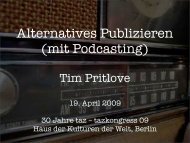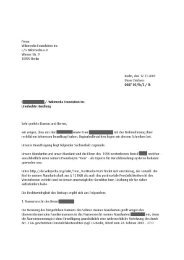Proceedings
Proceedings
Proceedings
Create successful ePaper yourself
Turn your PDF publications into a flip-book with our unique Google optimized e-Paper software.
ACADEMIC TOOLS AND REAL-LIFE BUG FINDING IN WIN32<br />
the ”len” parameter, an integer overflow will happen when<br />
calculating ”size” variable; malloc will allocate a memory<br />
block of size 0, and the subsequent memcpy will overwrite<br />
heap memory.<br />
This vulnerability has an important feature - usually a<br />
prover/checker does not have to understand loops semantic<br />
to detect this bug; simple arithmetics should suffice. It is well<br />
known that reasoning about loops is difficult 3 - usually it is<br />
required to manually provide a loop invariant, which is not<br />
trivial. Therefore, if we focus on detecting integer overflows<br />
in memory size calculations, we have a good chance of<br />
succeeding with automated checking. Also, this vulnerability<br />
is usually quite local, in the sense that the size calculation<br />
(which should include a check for integer overflow) is usually<br />
close to the actual memory allocation, which makes it possible<br />
to reliably detect the presence or lack of the vulnerability by<br />
analyzing a single function or a small number of functions.<br />
A. Summary<br />
III. NECESSARY COMPONENTS<br />
In order to reliably reason about the assembly code, two<br />
components are needed:<br />
• a decompiler capable of decoding single assembly instructions<br />
into a form with easily accessible semantics,<br />
as well as recovering higher level C code constructions;<br />
it is not necessary to produce a real C code, but as we<br />
will see we will choose this way<br />
• theorem prover or model checker, capable of reasoning<br />
about the code semantics<br />
As we will see, we will take a (modified and enhanced)<br />
decompiler, add functionality to automatically annotate the<br />
decompiled code with assertions which check for integer<br />
overflows, and then feed the decompiled code into the checker<br />
to verify the existence of integer overflows.<br />
Two excellent, publicly available academic tools: UQBT[1]<br />
and CBMC[7] were chosen for this task 4 ; they are briefly<br />
described below.<br />
B. CBMC: Bounded Model Checking for ANSI-C<br />
CBMC[7] is a checker capable of automatically proving<br />
properties of ANSI C code. The properties are embedded in the<br />
checked code in a form of usual C ”assert” statements. CBMC<br />
is unique in its ability to support almost all features of C<br />
language; particularly, the following constructions are handled<br />
well (while other C code checkers usually have problems with<br />
them):<br />
• arithmetics with bounded integers<br />
• pointer arithmetics<br />
• bitwise operations<br />
• function pointers<br />
CBMC works best on a code without loops. When a loop<br />
is present, CBMC can be instructed to unwind it a couple<br />
of times and possibly verify that a given number of unwind<br />
3Yes, undecidability. Each good paper should include this word at least<br />
once.<br />
4UQBTng uses a development version of CBMC, provided by its author<br />
operations is sufficient; however, in most cases, it is not<br />
enough. But as noted above, integer overflows are usually<br />
not caused by calculations implemented by a loop. Therefore,<br />
for the purpose of checking for integer overflows only, we<br />
can remove all looping constructions from the analyzed code,<br />
without significant loss of functionality. In such case, checking<br />
with CBMC is fully automatic; if an assertion does not hold,<br />
an appropriate counterexample is presented to the user.<br />
C. UQBT: University of Queensland Binary Translator<br />
UQBT[1] is an executable translator - it takes as input a<br />
binary file from an operating system A, decompiles it, and then<br />
it can produce a binary for a different system B, preserving<br />
the binary semantics.<br />
For our purposes, the most important capability of UQBT<br />
is its ability to decompile an executable into a graph of<br />
functions. Each instruction in a function is represented by a<br />
”semantic string”, a data structure capturing the semantics of<br />
an instruction. A lot of code is available to process semantic<br />
strings; for example, there is a function which can replace<br />
each occurrence of a subexpression (say, a dereference of a<br />
location pointed by a frame pointer minus a constant offset)<br />
in a semantic string with another expression (say, a semantic<br />
string describing a local variable). Therefore it is possible to<br />
process the instructions effectively and conveniently.<br />
Another tool was considered for the task of decompilation:<br />
The Interactive Disassembler[8]. However, IDA has numerous<br />
disadvantages:<br />
• The advanced functionality is not documented (besides<br />
sparse and insufficient comments in the header files).<br />
• Probably 5 the internal instruction representation is too<br />
close to the actual assembly; on the other hand, UQBT<br />
uses quite high level, portable representation.<br />
• There is no source available; it is a non-free software.<br />
The above issues (and a few others, less important) decided<br />
against IDA. Admittedly, IDA has some advantages; it is a<br />
very stable software and its accuracy in some aspects is very<br />
appealing (particularly, most of the PE file format analysis<br />
functionality implemented by the author so far for UQBTng<br />
is already present in IDA). However, in the long run UQBT<br />
should be the better choice.<br />
UQBT is a large piece of software; it can handle Pentium<br />
and Sparc architecture, and recognizes ELF, MSDOS .exe and<br />
(to some extent) Windows PE file formats. A useful feature<br />
is its ability to produce a C code from a binary; though<br />
not necessary for analysis (actually, analysis is done on the<br />
semantic strings, not on the C code), this makes it easy to<br />
produce input which a theorem prover or checker can work<br />
on.<br />
For our needs, the ability to decompile Win32 PE files is<br />
crucial. Functionality of UQBT had to be enhanced to process<br />
PE input files more accurately. The next section describes the<br />
most important modifications.<br />
5 The author tried to assess some aspects of IDA advanced functionality,<br />
however it was difficult due to the lack of the documentation; therefore this<br />
description may be not 100% accurate<br />
17 |






